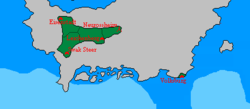Rossheim-Slavonia
| Herzogtum Rossheim-Slawonien Duchy of Rossheim-Slavonia | |||
| |||
| Motto: Belua tibi veniat | |||
| Anthem: Rossheim March (Unofficial) | |||

| |||
| Map versions | 14.9.5 - present | ||
| Capital | Neurossheim | ||
| Largest city | Neurossheim | ||
| Official language(s) | English, German | ||
| Official religion(s) | |||
| Demonym | Rossheimer | ||
| - Adjective | Rossheim, Rossheimish | ||
| Government | Necrarchy | ||
| - Duke | Max | ||
| - None | None | ||
| - Legislature | None | ||
| Establishment | 21 September 2012 | ||
| Area | 301,680 km² | ||
| Population | 1.1 million | ||
| Active population | 1 | ||
| Currency | Rossmark | ||
| Calendar | |||
| Time zone(s) | |||
| Mains electricity | |||
| Driving side | |||
| Track gauge | |||
| National website | None | ||
| National forum | forum | ||
| National animal | Sachsenross | ||
| National food | None | ||
| National drink | None | ||
| National tree | None | ||
| Abbreviation | RHM | ||
Rossheim-Slavonia, officially the Duchy of Rossheim-Slavonia (German: Herzogtum Rossheim-Slawonien), was a sovereign constituent state of the United Principalities of Treisenberg. It was established in 4795 ASC (21st September 2012) by the merger of the duchies of Rossheim-Slavonia-Volksburg and Rossheim-Leichberg and is the successor to the Principality of Rossheim founded in 2196 ASC (10th August 2005).
History
First Duchy of Rossheim
In 2113 ASC (19th May 2005), Franz Josef of Treisenberg granted the Slavic-speaking districts of eastern Cibola to the Saxon aristocrat Viscount Christoph von Rossheim, who became the first Duke of Slavonia (Old Slavonian: Vojvoda od Slavonija). Over the next five decades, the region was heavily settled by German-speaking colonists and in 2164 ASC (9th July 2005) was renamed the Duchy of Rossheim (Herzogtum Rossheim).
Shortly after joining Rhaetia and Morovina to form the first United Principalities of Treisenberg, in 2196 ASC (10th August 2005) the Duchy of Rossheim was proclaimed a sovereign principality. However, in 2290 ASC (Nov 12, 2005), the Grand Prince Franz Josef ceded the Treisenberg home islands to the Viking Empire of Stormark, causing the dissolution of the United Principalities and the subsequent collapse of the Principality of Rossheim.
Rossheim-Slavonia-Volksburg
The princely title was inherited by a junior branch of the House of Rossheim, who had ruled the Corumese Kingdom of Sangun since 2049 ASC (16th March 2005). Some of the Principality's surviving inhabitants subsequently settled in Sangun, where they came to be known as Cibolan Saxons (German: Siebenberger Sachsen; Sangunese: Shichisan Sakusen).
In 4546 ASC, an assembly of Cibolan Saxons petitioned the King of Sangun, Sadamara Aptrgangr to for a new homeland on Cibola and the next year, Sangunese officials established the Duchy of Rossheim-Slavonia-Volksburg as an autonomous constituent state of the Kingdom of Sangun, Riskai and the Idunn Isles. Although initially satisfied with the arrangement, by the beginning of the next century many Cibolan Saxons were disillusioned with the limited nature of their autonomy and in 4683 ASC (1st June 2012), Sadamara Aptrgangr agreed to give Rossheim-Slavonia-Volksburg its independence, having persuaded the Duchy's government to accept a young relative, Max von Rossheim, as their new duke.
Rossheim-Leichenberg
In 4779 ASC, the Duke's health collapsed, prompting the government to seek assistance from his distant cousin Anthrazita, Duchess of Lichbrook. The Duchess sent a team of necromancers to treat the Duke, on the understanding that when recovered, he would marry her daughter, Marie Dolores, Marchioness of Modania.
The Marchioness persuaded the Duke's chief minister, Karl Drosselmeyer, that the Duke could only be saved if his soul was magically bound to a remote mountain in the interior of the continent. The following a month, a small expedition reached the mountain and successfully performed the ritual, binding the souls of both the Duke and the Marchioness to the surrounding area, which subsequently became the nucleus of a second duchy, Rossheim-Leichenberg.
Union of the duchies
The Duke and his bride remained in their new duchy for nearly sixteen years, founding the city of Leichenberg on the ruins of the Germanian settlement of Hanover and using necromechanical labourers imported from Lichbrook to colonise the mountains, which proved to be rich in gold. Shortly after returning to Volksburg in 4795 ASC (21st September 2012), Duke Max proclaimed the union of Rossheim-Slavonia-Volksburg with Rossheim-Leichenberg and announced that the united duchy would be governed from a new capital, Neurossheim, established on the site of the Germanian city of Stuttgart.
In 4816 (12th October 2012), Duke Max expanded his territories to include the ancient cities of Eisenstadt and Swak Steer, which he resettled with Cibolan Saxon colonists. Later that year, he announced his intention to rule jointly with his wife and granted the Duchy a new constitution, which formally defined the relationship between its living and undead inhabitants.

